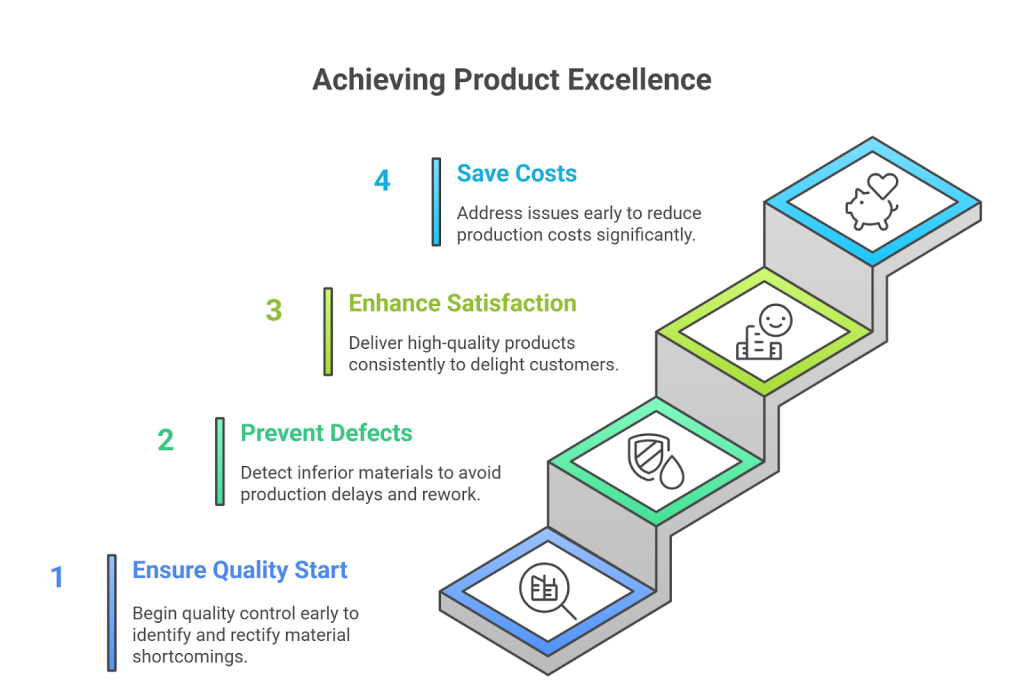
In the manufacturing world precision and quality are paramount. Companies must ensure that raw materials and components meet the highest standards. So, to determine the best quality, companies need inspection. Whether you are crafting promotional products or electronics, inspection plays a pivotal role in manufacturing.
For each material that comes in, there are some inspections that companies carry out. This is what is incoming inspection. For instance, reviewing an analysis certificate to ensure that the supplier follows the agreed-upon requirements to ensure all materials have the correct dimensions.
So, let’s have a more detailed look at this phenomenon.
What is Incoming Inspection in Manufacturing?
Incoming inspection or raw materials inspection is a quality control process that companies must perform after receiving materials and components from suppliers. It involves assessing the quality, conforming to specifications and overall suitability of all incoming items.
Conducting chemical testing and analysis which includes composition and trace contamination identification on raw materials may help to increase the quality of the final product.
It also prevents end product quality control rejection or even performs a product recall even when the product is already on the market.
Role of Raw Materials Inspection in Supply Chain
Incoming inspection is a crucial bridge in the supply chain. It acts as a gatekeeper to ensure only high-quality materials and components proceed to production. This type of inspection validates the manufacturing company buying any materials based on set acceptance criteria. A quality assurance personnel performs the check ensuring the topmost quality of all the materials.
Key Goals of Incoming Inspection
- Verify how accurate the document-like specifications and certifications
- Identify any visible defects or damages
- Conduct dimensional and functional tests to ensure conformity
- For quality validation use sampling and statistical analysis
After all of this, ensure that you also have the approval of the regulatory board.
Ensuring Compliance with Industry Standards and Regulations: It is equally important to adhere to industry-specific standards. This is a fundamental part of material inspection. This not only ensures products meet internal quality standards but also complies with external requirements.
Importance of Incoming Inspection

Here is why companies need inward inspection:
1. Ensuring Product Quality from the Very Start
Commencing quality control at the earliest stages of manufacturing is imperative. Conducting incoming inspections enables manufacturers to identify and rectify any shortcomings in raw materials or components. They can do so before their integration into the final product. This proactive approach ensures that the result will exceed customers’ expectations.
2. Preventing Defects and Production Delays
Early detection of inferior materials or components prevents defects from permeating throughout the manufacturing process. This not only conserves time and resources but also mitigates production delays and the need for costly rework.
3. Enhancing Customer Satisfaction and Brand Reputation
The cornerstone of customer satisfaction lies in delivering high-quality products consistently. By maintaining stringent quality standards for incoming inspection, you not only delight your customers but also bolster your brand’s reputation for dependability and excellence.
4. Cost-Saving through Early Detection of Issues
Promptly addressing quantity inspection while receiving is done against the products before they escalate can lead to substantial reductions in production costs. Rectifying defects during the initial stages of manufacturing proves to be far more economical than dealing with issues once they have infiltrated the finished product.
Knowing the process, it is now time to see how the manufacturers carry it out.
The Process of Incoming Inspection: The Ultimate Guide
The incoming inspection process includes multiple steps to assess the quality and compliance of received materials. Let’s have a look at the guide to conducting an effective inspection for manufacturing products:
1. Receiving Raw Materials and Components
The first step is to receive the materials from suppliers and vendors. This can include items like fabrics, plastic components, printing materials and packaging materials. Proper measures should be in place to verify the accuracy of quantity and packaging integrity in the receiving process.
2. Verify Quality and Quantity
Then the manufacturer cross-checks the received materials against the purchase order to ensure the correct quantity has been delivered. Inspectors also examine the packaging for any signs of damage that could have happened during transit. This step identifies potential issues that may affect the integrity or usability of the materials.
3. Assessing Specifications and Criteria
Each material or component has specific requirements and specifications. Inspectors compare these specifications to the documentation they have like engineering drawings or quality control standards. Check for factors like dimensions, colour, material composition and other special factors that need to be present.
4. Inspecting for Defects and Damages
In this important step, inspectors examine the received materials for any defects, damages or inconsistencies. They usually use tools like visual, inspection, measuring devices, or functional testing. This depends on the elements of the materials. It helps to identify any non-conformities or deviations from the expected quality.
5. Collaborating with Suppliers
During the incoming inspection process, the experts may need to communicate with the suppliers or vendors regarding any identified issues. This collaboration may address concerns, clarify specifications or negotiate returns, replacements or corrective actions.
6. Documenting Inspection Findings
It is essential to document all inspection findings, including the results and observations. Such documentation serves as a record of the inspection process, facilitates traceability and provides a reference for future analysis and improvement.
With that let’s see some of the benefits of raw materials inspection.
4 Incoming Quality Control Inspection Benefits
Here are some of the benefits that companies can harness when it comes to this type of inspection:
During product inspection, you ensure the correction of every defective item inside your synthetic batches. This practice continues the pleasantness of released products and reduces the probability of faulty items entering the marketplace.
1. Better Quality Control
In any manufacturing process, a few defective pieces get manufactured in a batch. This may happen because of a technical error or some other reason.
During Product inspection, the products undergo a thorough inspection. They get inspected for any errors or malfunctions and companies make sure to send the faulty products back for correction. This gives them more control over the quality of their products and they do not have to rely on chances.
2. Enhanced Brand Reputation
Thorough incoming material inspection guarantees the discharge of only faultless products, enhancing emblem recognition and increasing customer satisfaction. A nice popularity ends in better sales and smoother advertising and marketing efforts.
3. Opportunity for Corrections
Conducting DPI when merchandise is 40%-50% finished allows for smooth rectification of faults. Identifying problems at this level helps with timely corrections, minimising production setbacks.
4. Strengthened Production Chain
DPI does not obstruct the manufacturing manner; instead, it fortifies it. In-process inspection prevents the production of faulty items, making sure of the steady delivery of notable products. This, in turn, boosts productivity and enhances the average manufacturing performance of incoming quality control.
Conclusion
Incoming inspection in manufacturing is indispensable for maintaining precision and quality standards. It ensures that materials and components meet rigorous criteria, preventing defects and production delays.
This systematic approach, coupled with effective collaboration and documentation, strengthens the entire production chain, fostering efficiency and excellence in manufacturing. Head over to Qodenext for more supply chain solutions!.
FAQs: What is the Need for Incoming Inspection in Manufacturing
1. What are the types of incoming inspections?
There are three types: pre-production, in-line, and final.
2. What is the final inspection process?
The last check that manufacturers do is for the quality of the products. Also known as quality checks they detect quality issues that they might have missed earlier.
3. What is the inspection order?
These orders’ purpose is to track activities involved in inspecting items coming in or going from the inventory. The reason for creating them might be Purchase Receipts., Manufacturing Work Order Receipts and Return Material Authorisation.
4. What is an incoming inspection standard?
An incoming inspection standard is a set of guidelines used to evaluate the quality of raw materials or components upon their arrival at a manufacturing facility.
5. What is the first inspection?
The initial article inspection (IAI) plays a crucial role in the manufacturing process, guaranteeing adherence to precise specifications and fulfilling customer demands. IAI entails scrutinising a sample of the first product produced in a batch to verify compliance with all quality criteria.
6. Why is incoming quality inspection necessary?
- Preventing defects
- Ensuring product quality
- Reducing costs
- Meeting regulatory requirements
- Protecting brand reputation
7.How does this type of inspection benefit promotional product manufacturers?
It mitigates risk by identifying and eliminating material issues early. This reduces production delays, preventing defective merchandise and minimising the likelihood of costly calls.
8. What are the challenges of this type of inspection?
Some of the roadblocks include time constraints, diverse materials, and ensuring accurate assessments. Manufacturers can address them with technology integration, standardised products, comprehensive training and a robust communication system with the suppliers.






